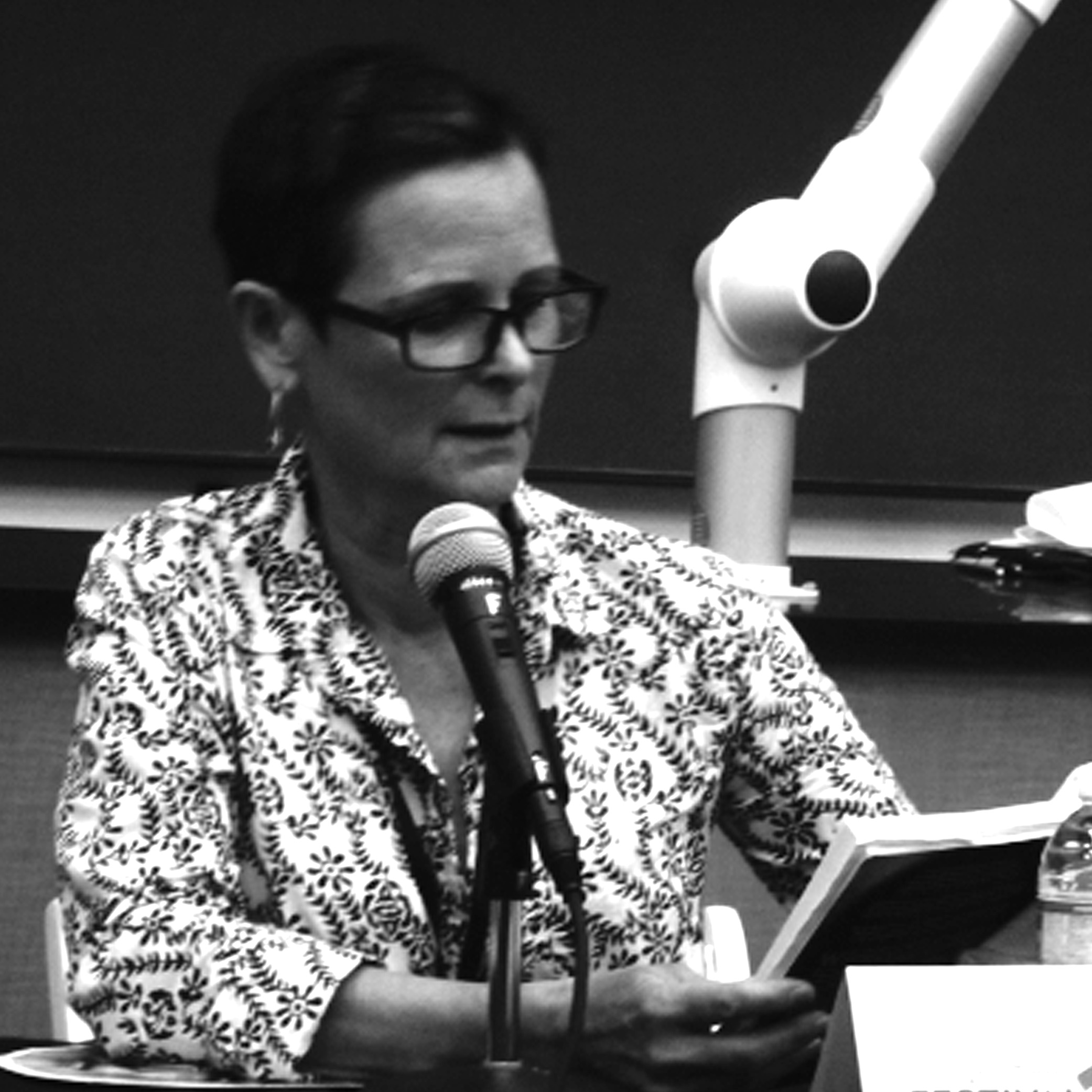A Bit Contrived
features interviews with authors who exist about books that don't, with covers designed by people who do.
Our complete list of conversations, including:
Pixelated, the digital, double-blind, lit-inclined author chat
The Art of Commerce, exploring the intersection of literature and the market
Please note: Dying Fabric and Making Gunpowder does not exist, nor will it ever (probably)—it's been improvised during the course of the interview. If you really want to read it, do yourself a favor and check out Diana's most recent novel, Life #6.
Release no. IX:
Dying Fabric and Making Gunpowder by Diana Wagman
Published 7/20/15
Diana asked me to meet her on the side of Interstate 405, at a certain mile marker, and said she’d “swing by around noon”. I was a bit apprehensive about oncoming traffic, but when I got there, I was thankful to find that the cars didn’t really move at all. By the time she arrived it was three o’clock. ‘Traffic,’ she said, and rolled her eyes. When I got in I started to speak but she shushed me, and pointed to her ear. After a minute or so she spoke again. ‘You hear that?’ she asked, clearly rhetorically. ‘That’s the journey. That’s the journey that never ends.’ Below are excerpts from our conversation.
Diana. In Dying Fabric and Making Gunpowder, I believe, you've helped to salvage the gaping hole in E.M. Forster's Aspects of the Novel. It goes without saying, nonetheless: his concepts of fantasy and prophecy. No one doubts he was on to something useful, but in practice we're left with a furrowed brow and an agape, childlike mouth. What does he mean? thousands of slack-jawed MFA students ponder. Well, I'd say to them if I ever I came across them at this moment of disturbance, take a peak at Diana Wagman's newest novel. The first half: fantasy; the second: prophecy. You've neatly divided the two and attached shining exemplars, and so we can finally put that book away deep in the lowest drawer. Onto the critics. Leland Floyd at Publishers Weekly: "Wagman really wags the dog with this one." Lisette Elizondo at the Washington Post: "Man, someone oughtta wag this book into my face." Who pays these people? Moving on: at what point in the process did you realize what you were doing with DFaMG?
Thank you, Andrew. I'm so glad and impressed that you understood my true intent with this novel. As E.M. Forster said in his flawed but useful text, "The only books that influence us are those for which we are ready, and which have gone a little farther down our particular path than we have yet got ourselves." You have traveled this particular path and I trust I have taken you farther than you expected. With DFaMG I attempted not only paths, but entire triple level freeways--being from Los Angeles as I am--that would intersect and flow between those two worlds of fantasy and prophecy. As a writer I am always more interested in the journey than the destination and as I found myself somewhere between Uber and a 2025 Tesla and yes, even the next generation of, dare I say, flying vehicles, I found myself in uncharted worlds. This book was not so much mapped as experienced.
Mmmm. So much rich context here. Connecting Los Angeles infrastructure to the subtext of your book is novel. Let's talk about that more. How else did "The City of Angels" speak to you, and what else of its migraine-inducing transport?
Almost all of my writing life, certainly my novel writing life, has been spent in Los Angeles. I hear the freeway traffic as I sit at my computer. That noise, that atonal symphony of people rushing back and forth is the soundtrack to everything I write. After years, it seems now I hear it louder than ever. It is more intrusive and it bled into this book. Traffic, bad traffic, stalled traffic where the freeway becomes a parking lot and it takes hours to move ten miles, often makes a driver wish she could reach for the Gunpowder, but it isn't that simple. There is the Dying Fabric as well. For those who haven't read the book, and that one critic who got it completely wrong, Dying isn't about turning cotton from white to blue, but about death. Time spent in a car stuck in traffic is an experience like death, the car the coffin, the seats our shrouds, NPR on the radio the voice of the priest delivering our eulogy.
But I don't want to be morbid. The novel is truly a celebration. What's ahead of us might be a dead end. But it might just as possibly not be.
“The cold and wet in direct opposition to the cliched mother’s warm embrace. And my research indicates freezing to death is actually pleasant.”
Well certainly even a toddler wouldn't think you meant 'dying' as in wool.
These themes of static motion, static existence, static on NPR (excuse the pun, ha!)—all these run counter to the plot itself, doesn't it? I mean, these characters are moving. I'd like for you to speak to me about that in an equally abstruse, abstract and open-ended tone.
I took a class from a playwright many years ago who constantly quoted Sam Smiley, "Drama is character in action." Give a character a goal, put him or her on the road to the goal, and a story takes off. I wanted my main character, Jane, to be 1) beautiful in direct opposition to the Plain Jane moniker and 2) to be tough, determined, and relentless in pursuit of her goal. Not just a signifier but a real, flesh and blood living woman with whom the reader can identify. She spits, she eats, she leaves that baby in the snow, but she never stops going forward. Recently there has been a lot of discussion among my writer friends about women characters being "likable." I think likable is the wrong word. A character is the sum of the entire Cleveland Cavaliers team, a gem of many facets, some bad, some good, some dull and some shiny, not just LeBron James. He's likable, even lovable, but he's not enough. A character needs all the players and all their personalities wrapped up together. The Cavs failed at their goal, but they gave it everything they had and that's what's important in a character that moves. She tries. She attempts. She goes after what she wants. And if she's a bitch along the way, the reader will understand. All the great characters in literature are complicated and at times not very nice. I think this is much less abstract than you wanted, but while theme can wag that dog all it wants, character must sit down and stay.
There was that moment when Jane leaves the baby in the snow. I remember reading it and thinking "now that is a round character." Out of context it would seem that would make her seem unlikable, sure, but eventually the reader has to understand. Is Jane based on someone you know or pure imagination? How about the other characters she encounters?
They say a writer always writes about herself, but I think I always write about my best friend from childhood, Laurie Myers. I don't know where she is now, but I so wanted to be her, have her hair and her smile and her mathematical abilities. She was a mover for sure and she flew through those workbooks in elementary school with perfect scores and always got to go to recess early. I have modeled my life after her. Of course she moved away when I was nine so I've had to modify my modeling somewhat. I eat more than tomato sandwiches. I stay up past 8:30. I don't know if she had a baby; I certainly don't know if she left that baby anywhere, but I know she was capable of it. I know that wherever she is now she could and would sacrifice the one to save the many--or even just herself. I am not as strong. I would have carried that baby even though surely we would both die in that storm, so I tempered Jane a little with my own sensibilities. I haven't seen snow in many years, but what better place to leave a baby? The cold and wet in direct opposition to the cliched mother's warm embrace. And my research indicates freezing to death is actually pleasant. Baltham, the love interest, is again like Laurie. Yes, he eats only tomato sandwiches, but also because he watches, he plans, he calculates. He is always one step ahead, another of her traits. Even Rocco, the grasping brother, is based on my memories of Laurie. She wanted so much to be invited to a particular party--just like Rocco--and she too told her friends she was invited when she absolutely was not. Sneaky, but successful.
A friend who read the book asked me if I thought the characters were "unrealistically honest". I thought she had a point, and I thought about, and I couldn't figure it out—until now. They're not too "honest", it's just that their foundations are that of children. We have characters without any of the inhibitions, the muddy intentions, the unnecessary complexities of adults. This, I believe, is how you achieved Forster's prophecy, that is the accent of your work: who the characters would be (and, in turn, who we'd be) if we never became who we are.
Let's move to the ending, which left me, quite honestly, confused. I'm not asking you to reveal your secrets here, but maybe a nudge in the right direction?
Andrew, I'm so glad to hear you say that. The ending is confusing by intent. The childlike characters, (yes! thank you for seeing that as well! you are brilliant!), the storm, the party, and Foster's prophecy about things growing down instead of up, sinking deeper into the mud and getting under the concrete of daily life, is impossible for our limited minds to grasp. I dreamed it. I had a vision of the underneath world he foretells in which he said to me, me Diana, that one day home will be where our roots extend. It's like the traditional Balinese who bury the placenta underneath the family compound so no child can travel very far without feeling the tug. The vision was clear, but the writing is purposefully not so that the reader can feel the earth under his own feet right wherever he is sitting. And here we have returned to the metaphor of traveling, of going down an unknown path, either on foot or in our minds, which is completely by design.
Thank you so much for this opportunity. And thank you so much for truly understanding my book.
Delectable, mightily. A high school english teacher recently told me if there's anything he hopes is students will find in literature, it's to be lost. You kept us so in line throughout, and then let us be lost, downward, to finish. Magnificent.
Thank you Diana.
Cover by Jason Ramirez. Jason is a graphic designer based in New York City. He currently designs book covers and jackets for the Penguin Group. Previously he worked with St. Martin's Press and Rodrigo Corral Design in New York. Originally from Kansas, Jason is a graduate of Parsons School of Design and the University of Rochester. He has worked with various publishers, including Atlas & Co.; Farrar, Strauss Giroux; Penguin; Scott & Nix; Tor; Viking; Vintage; and W.W. Norton.
Are you a graphic designer who wants to contribute a cover to A Bit Contrived? Get in touch: editor [at] 0s-1s [dot] com.




